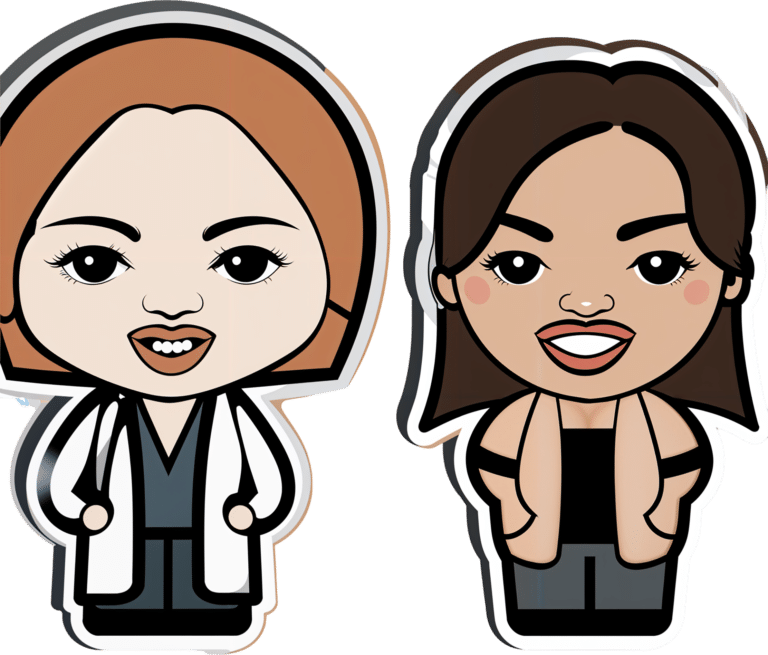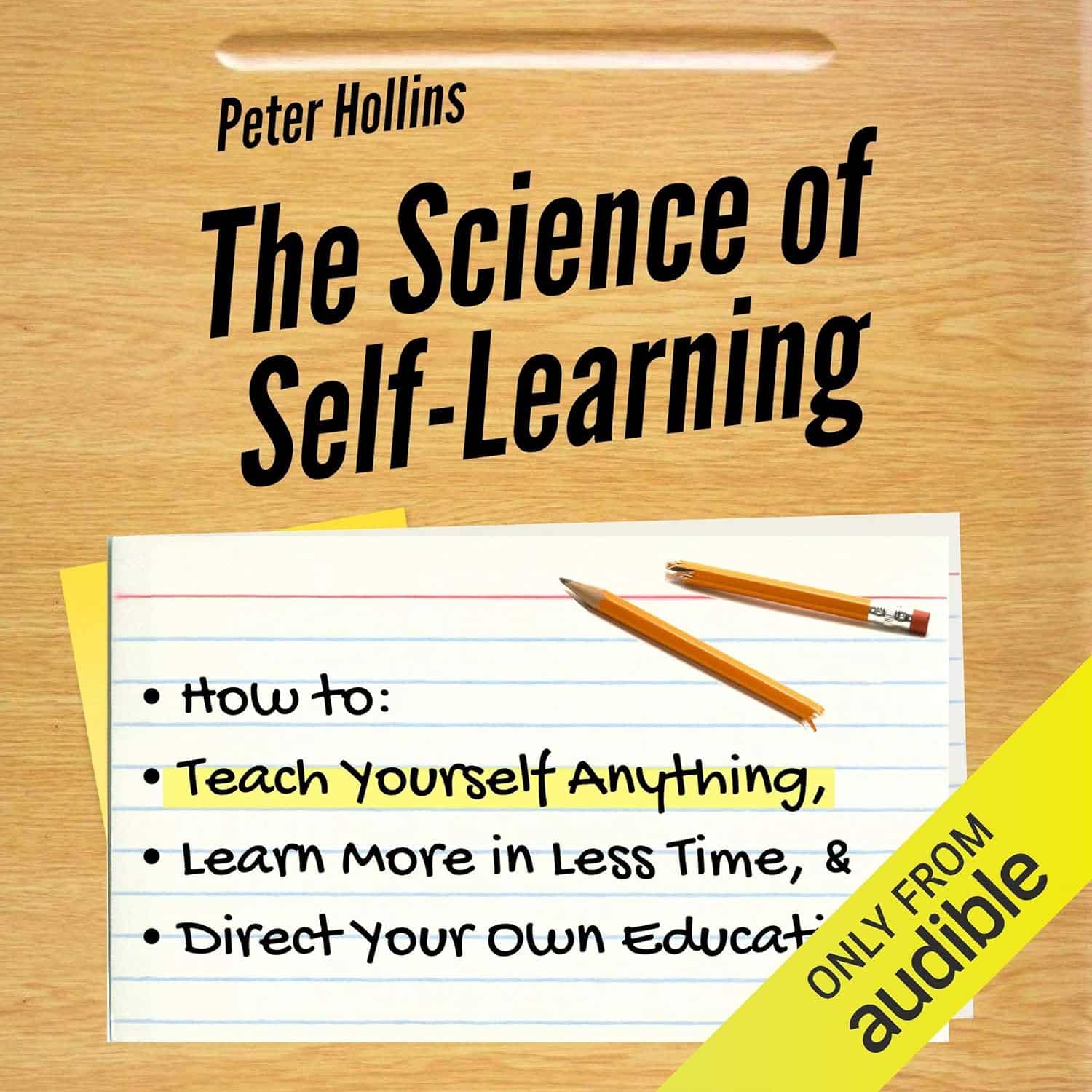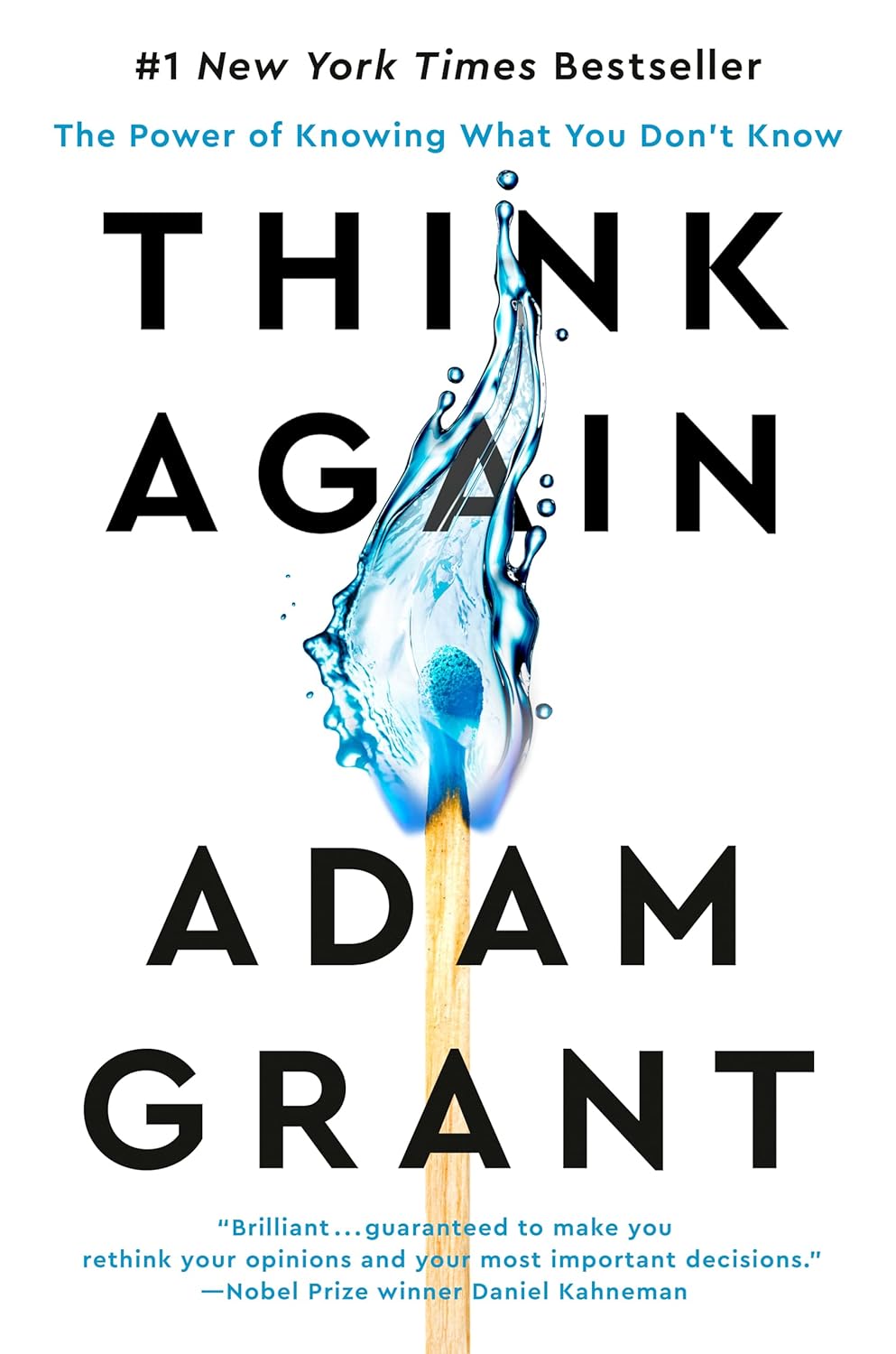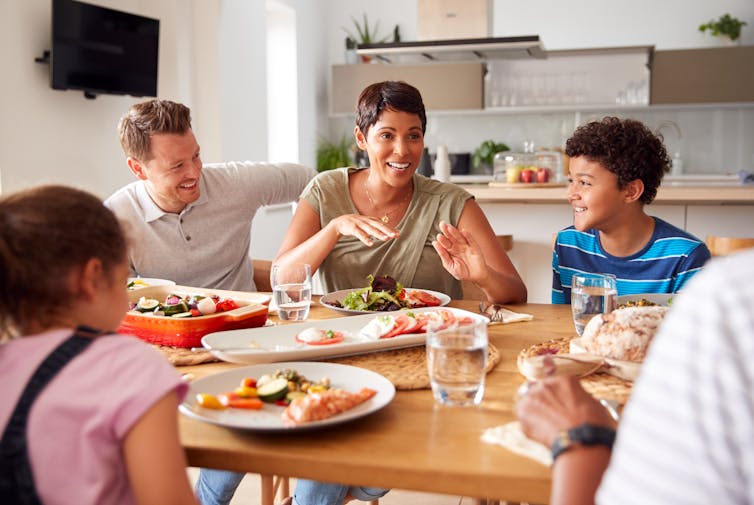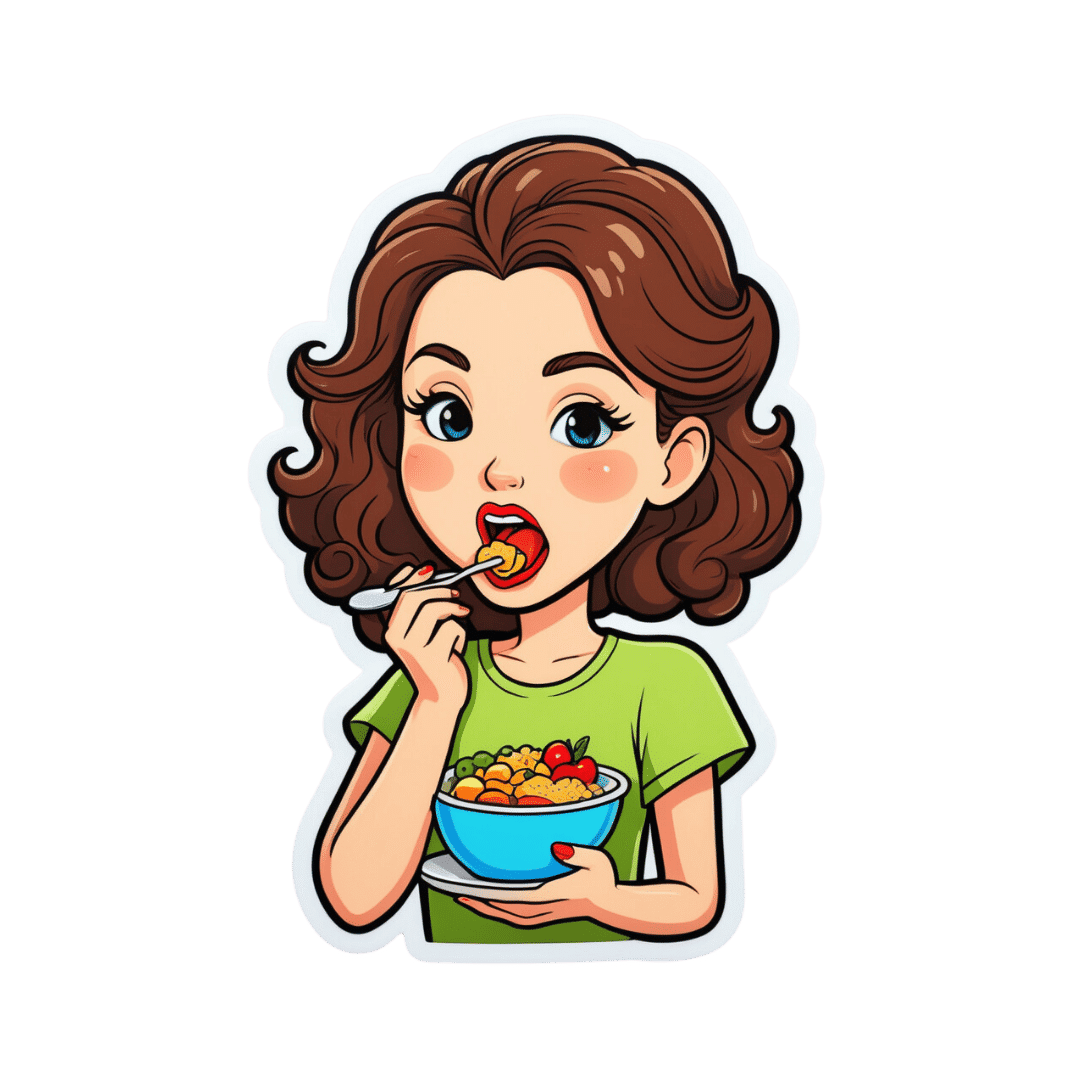
How can I stop using food to cope with negative emotions?
10almonds is reader-supported. We may, at no cost to you, receive a portion of sales if you purchase a product through a link in this article.
Have you ever noticed changes in your eating habits when you are sad, bored or anxious?
Many people report eating either more, or less, as a way of helping them to cope when they experience difficult emotions.
Although this is a very normal response, it can take the pleasure out of eating, and can become distressing and bring about other feelings of shame and self-criticism.
Adding to the complexity of it all, we live in a world where diet culture is unavoidable, and our relationship to eating, food and body image can become complicated and confusing.

Emotional eating is common
“Emotional eating” refers to the eating behaviours (typically eating more) that occur in response to difficult emotions.
Research shows around 20% of people regularly engage in emotional eating, with a higher prevalence among adolescents and women. In a study of more than 1,500 adolescents, 34% engaged in emotional eating while sad and 40% did so while anxious.
Foods consumed are often fast-foods and other energy-dense, nutrient-poor convenience foods.
Stress, strong emotions and depression
For some people, emotional eating was simply a habit formed earlier in life that has persisted over time.
But other factors might also contribute to the likelihood of emotional eating. The physiological effects of stress and strong emotions, for example, can influence hormones such as cortisol, insulin and glucose, which can also increase appetite.
Increased impulsivity (behaving before thinking things through), vulnerability to depression, a tendency to ruminate and difficulties regulating emotions also increase the likelihood of emotional eating.
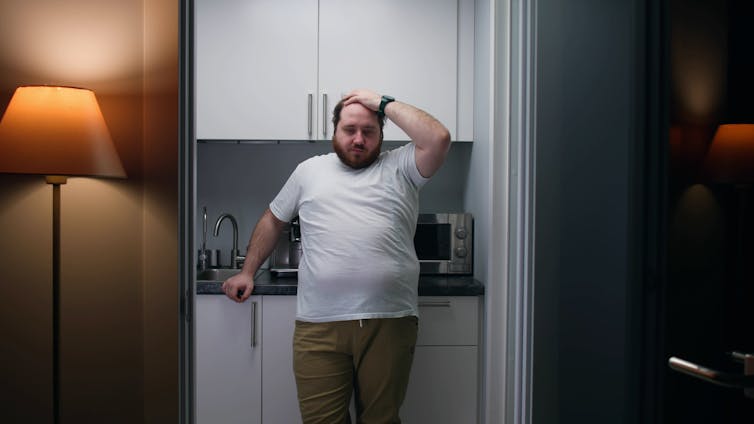
So what do you do?
First, know that fluctuations in eating are normal. However, if you find that the way you eat in response to difficult emotions is not working for you, there are a few things you can do.
Starting with small things that are achievable but can have a huge impact, such as prioritising getting enough sleep and eating regularly.
Then, you can start to think about how you handle your emotions and hunger cues.
Expand your emotional awareness
Often we label emotions as good or bad, and this can result in fear, avoidance, and unhelpful coping strategies such as emotional eating.
But it’s also important to differentiate the exact emotion. This might be feeling isolated, powerless or victimised, rather than something as broad as sad.
By noticing what the emotion is, we can bring curiosity to what it means, how we feel in our minds and bodies, and how we think and behave in response.
Tap into your feelings of hunger and fullness
Developing an intuitive way of eating is another helpful strategy to promote healthy eating behaviours.
Intuitive eating means recognising, understanding and responding to internal signals of hunger and fullness. This might mean tuning in to and acknowledging physical hunger cues, responding by eating food that is nourishing and enjoyable, and identifying sensations of fullness.
Intuitive eating encourages flexibility and thinking about the pleasure we get from food and eating. This style of eating also allows us to enjoy eating out with friends, and sample local delicacies when travelling.
It can also reduce the psychological distress from feeling out of control with your eating habits and the associated negative body image.
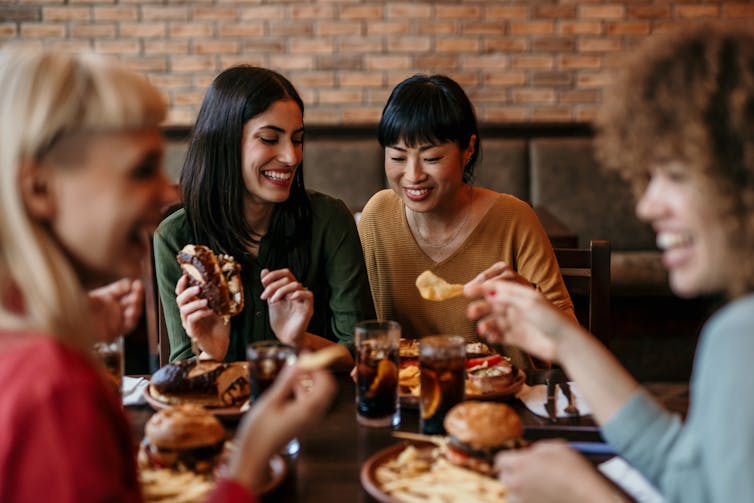
When is it time to seek help?
For some people, the thoughts and behaviours relating to food, eating and body image can negatively impact their life.
Having the support of friends and family, accessing online resources and, in some instances, seeing a trained professional, can be very helpful.
There are many therapeutic interventions that work to improve aspects associated with emotional eating. These will depend on your situation, needs, stage of life and other factors, such as whether you are neurodivergent.
The best approach is to engage with someone who can bring compassion and understanding to your personal situation, and work with you collaboratively. This work might include:
- unpacking some of the patterns that could be underlying these emotions, thoughts and behaviours
- helping you to discover your emotions
- supporting you to process other experiences, such as trauma exposure
- developing a more flexible and intuitive way of eating.
One of the dangers that can occur in response to emotional eating is the temptation to diet, which can lead to disordered eating, and eating disorder behaviours. Indicators of a potential eating disorder can include:
- recent rapid weight loss
- preoccupation with weight and shape (which is usually in contrast to other people’s perceptions)
- eating large amounts of food within a short space of time (two hours or less) and feeling a sense of loss of control
- eating in secret
- compensating for food eaten (with vomiting, exercise or laxatives).
Evidence-based approaches can support people experiencing eating disorders. To find a health professional who is informed and specialises in this area, search the Butterfly Foundation’s expert database.
If this article has raised issues for you, or if you’re concerned about someone you know, call Lifeline on 13 11 14, or the Butterfly Foundation on 1800 ED HOPE (1800 33 4673).
Inge Gnatt, PhD Candidate, Lecturer in Psychology, Swinburne University of Technology
This article is republished from The Conversation under a Creative Commons license. Read the original article.
Don’t Forget…
Did you arrive here from our newsletter? Don’t forget to return to the email to continue learning!
Recommended
Learn to Age Gracefully
Join the 98k+ American women taking control of their health & aging with our 100% free (and fun!) daily emails:
-
The Science of Self-Learning – by Peter Hollins
10almonds is reader-supported. We may, at no cost to you, receive a portion of sales if you purchase a product through a link in this article.
Teaching oneself new things is often the most difficult kind of bootstrapping, especially when one is unsure of such critical things as:
- Where to begin? How, for that matter, do we find where to begin?
- What can/should a learning journey look like?
- What challenges should we expect, and how will we overcome them?
Hollins answers all of these questions and more. The greatest value of this book is perhaps in its clear presentation of concrete step-by-step instructions. Hollins gives illustrated examples too, but most importantly, he gives models that can be applied to any given type of learning.
The book also covers the most difficult problems most people face when trying to learn something by themselves, including:
- Keeping oneself on-task (maintaining discipline)
- Measuring progress (self-testing beyond memorization)
- Keeping a fair pace of progress (avoiding plateaus)
- How to know when one’s knowledge is sufficient or not (avoiding Dunning-Kruger Club)
All in all, if you’re looking to learn a new subject or skill, this could be a first step that saves you a lot of time later!
Get your copy of the Science of Self-Learning on Amazon today!
Share This Post
-
Think Again – by Adam Grant
10almonds is reader-supported. We may, at no cost to you, receive a portion of sales if you purchase a product through a link in this article.
Warning: this book may cause some feelings of self-doubt! Ride them out and see where they go, though.
It was Socrates who famously (allegedly) said “ἓν οἶδα ὅτι οὐδὲν οἶδα”—”I know that I know nothing”.
Adam Grant wants us to take this philosophy and apply it usefully to modern life. How?
The main premise is that rethinking our plans, answers and decisions is a good thing… Not a weakness. In contrast, he says, a fixed mindset closes us to opportunities—and better alternatives.
He wants us to be sure that we don’t fall into the trap of the Dunning-Kruger Effect (overestimating our abilities because of being unaware of how little we know), but he also wants us to rethink whole strategies, too. For example:
Grant’s approach to interpersonal conflict is very remniscent of another book we might review sometime, “Aikido in Everyday Life“. The idea here is to not give in to our knee-jerk responses to simply retaliate in kind, but rather to sidestep, pivot, redirect. This is, admittedly, the kind of “rethinking” that one usually has to rethink in advance—it’s too late in the moment! Hence the value of a book.
Nor is the book unduly subjective. “Wishy-washiness” has a bad rep, but Grant gives us plenty in the way of data and examples of how we can, for example, avoid losses by not doubling down on a mistake.
What, then, of strongly-held core principles? Rethinking doesn’t mean we must change our mind—it simply means being open to the possibility in contexts where such makes sense.
Grant borrows, in effect, from:
❝Do the best you can until you know better. Then when you know better… do better!❞
So, not so much undercutting the principles we hold dear, and instead rather making sure they stand on firm foundations.
All in all, a thought-provokingly inspiring read!
Share This Post
-
The Sweet Truth About Glycine
10almonds is reader-supported. We may, at no cost to you, receive a portion of sales if you purchase a product through a link in this article.
Make Your Collagen Work Better
This is Dr. James Nicolantonio. He’s a doctor of pharmacy, and a research scientist. He has a passion for evidence-based nutrition, and has written numerous books on the subject.
Controversy! Dr. DiNicolatonio’s work has included cardiovascular research, in which field he has made the case for increasing (rather than decreasing) the recommended amount of salt in our diet. This, of course, goes very much against the popular status quo.
We haven’t reviewed that research so we won’t comment on it here, but we thought it worth a mention as a point of interest. We’ll investigate his claims in that regard another time, though!
Today, however, we’ll be looking at his incisive, yet not controversial, work pertaining to collagen and glycine.
A quick recap on collagen
We’ve written about collagen before, and its importance for maintaining… Well, pretty much most of our body, really, buta deficiency in collagen can particularly weaken bones and joints.
On a more surface level, collagen’s also important for healthy elastic skin, and many people take it for that reason alone,
Since collagen is found only in animals, even collagen supplements are animal-based (often marine collagen or bovine collagen). However, if we don’t want to consume those, we can (like most animals) synthesize it ourselves from the relevant amino acids, which we can get from plants (and also laboratories, in some cases).
You can read our previous article about this, here:
We Are Such Stuff As Fish Are Made Of
What does he want us to know about collagen?
We’ll save time and space here: first, he’d like us to know the same as what we said in our article above
However, there is also more:
Let’s assume that your body has collagen to process. You either consumed it, or your body has synthesized it. We’ll skip describing the many steps of collagen synthesis, fascinating as that is, and get to the point:
When our body weaves together collagen fibrils out of the (triple-helical) collagen molecules…
- the cross-linking of the collagen requires lysyl oxidase
- the lysyl oxidase (which we make inside us) deanimates some other amino acids yielding aldehydes that allow the stable cross-links important for the high tensile strength of collagen, but to do that, it requires copper
- in order to use the copper it needs to be in its reduced cuprous form and that requires vitamin C
- but moving it around the body requires vitamin A
So in other words: if you are taking (or synthesizing) collagen, you also need copper and vitamins A and C.
However! Just to make things harder, if you take copper and vitamin C together, it’ll reduce the copper too soon in the wrong place.
Dr. DiNicolantonio therefore advises taking vitamin C after copper, with a 75 minutes gap between them.
What does he want us to know about glycine?
Glycine is one of the amino acids that makes up collagen. Specifically, it makes up every third amino acid in collagen, and even more specifically, it’s also the rate-limiting factor in the formation of glutathione, which is a potent endogenous (i.e., we make it inside us) antioxidant that works hard to fight inflammation inside the body.
What this means: if your joints are prone to inflammation, being glycine-deficient means a double-whammy of woe.
As well as being one of the amino acids most key to collagen production, glycine has another collagen-related role:
First, the problem: as we age, glycated collagen accumulates in the skin and cartilage (that’s bad; there is supposed to be collagen there, but not glycated).
More on glycation and what it is and why it is so bad:
Are You Eating Advanced Glycation End-Products? The Trouble Of The AGEs
Now, the solution: glycine suppresses advanced glycation end products, including the glycation of collagen.
See for example:
With these three important functions of glycine in mind…
Dr. DiNicolantonio therefore advises getting glycine at a dose of 100mg/kg/day. So, if you’re the same size as this rather medium-sized writer, that means 7.2g/day.
Where can I get it?
Glycine is found in many foods, including gelatin for those who eat that, eggs for the vegetarians, and spinach for vegans.
However, if you’d like to simply take it as a supplement, here’s an example product on Amazon
(the above product is not clear whether it’s animal-derived or not, so if that’s important to you, shop around. This writer got some locally that is certified vegan, but is in Europe rather than N. America, which won’t help most of our subscribers)
Note: pure glycine is a white crystalline powder that has the same sweetness as glucose. Indeed, that is how it got its name, from the Greek “γλυκύς”, pronounced /ɡly.kýs/, meaning “sweet”. Yes, same etymology as glucose.
So don’t worry that you’ve been conned if you order it and think “this is sugar!”; it just looks and tastes the same.
That does mean you should buy from a reputable source though, as a con would be very easy!
this does also mean that if you like a little sugar/sweetener in your tea or coffee, glycine can be used as a healthy substitute.
If you don’t like sweet tastes, then, condolences. This writer pours two espresso coffees (love this decaffeinated coffee that actually tastes good), puts the glycine in the first, and then uses the second to get rid of the sweet taste of the first. So that’s one way to do it.
Enjoy (if you can!)
Share This Post
Related Posts
-
Our family is always glued to separate devices. How can we connect again?
10almonds is reader-supported. We may, at no cost to you, receive a portion of sales if you purchase a product through a link in this article.
It’s Saturday afternoon and the kids are all connected to separate devices. So are the parents. Sounds familiar?
Many families want to set ground rules to help them reduce their screen time – and have time to connect with each other, without devices.
But it can be difficult to know where to start and how to make a plan that suits your family.
First, look at your own screen time
Before telling children to “hop off the tech”, it’s important parents understand how much they are using screens themselves.
Globally, the average person spends an average of six hours and 58 minutes on screens each day. This has increased by 13%, or 49 minutes, since 2013.
Parents who report high screen time use tend to see this filtering down to the children in their family too. Two-thirds of primary school-aged children in Australia have their own mobile screen-based device.
Australia’s screen time guidelines recommended children aged five to 17 years have no more than two hours of sedentary screen time (excluding homework) each day. For those aged two to five years, it’s no more than one hour a day. And the guidelines recommend no screen time at all for children under two.
Yet the majority of children, across age groups, exceed these maximums. A new Australian study released this week found the average three-year-old is exposed to two hours and 52 minutes of screen time a day.
Some screen time is OK, too much increases risks
Technology has profoundly impacted children’s lives, offering both opportunities and challenges.
On one hand, it provides access to educational resources, can develop creativity, facilitates communication with peers and family members, and allows students to seek out new information.
On the other hand, excessive screen use can result in too much time being sedentary, delays in developmental milestones, disrupted sleep and daytime drowsiness.
Disrupted sleep can leave children tired the next day.
Yulia Raneva/ShutterstockToo much screen time can affect social skills, as it replaces time spent in face-to-face social interactions. This is where children learn verbal and non-verbal communication, develop empathy, learn patience and how to take turns.
Many families also worry about how to maintain a positive relationship with their children when so much of their time is spent glued to screens.
What about when we’re all on devices?
When families are all using devices simultaneously, it results in less face-to-face interactions, reducing communication and resulting in a shift in family dynamics.
The increased use of wireless technology enables families to easily tune out from each other by putting in earphones, reducing the opportunity for conversation. Family members wearing earphones during shared activities or meals creates a physical barrier and encourages people to retreat into their own digital worlds.
Wearing earphones for long periods may also reduce connection to, and closeness with, family members. Research from video gaming, for instance, found excessing gaming increases feelings of isolation, loneliness and the displacement of real-world social interactions, alongside weakened relationships with peers and family members.
How can I set screen time limits?
Start by sitting down as a family and discussing what limits you all feel would be appropriate when using TVs, phones and gaming – and when is an appropriate time to use them.
Have set rules around family time – for example, no devices at the dinner table – so you can connect through face-to-face interactions.
One rule might be no devices at the dinner table.
Monkey Business Images/ShutterstockConsider locking your phone or devices away at certain periods throughout the week, such as after 9pm (or within an hour of bedtime for younger children) and seek out opportunities to balance your days with physical activities, such kicking a footy at the park or going on a family bush walk.
Parents can model healthy behaviour by regulating and setting limits on their own screen time. This might mean limiting your social media scrolling to 15 or 30 minutes a day and keeping your phone in the next room when you’re not using it.
When establishing appropriate boundaries and ensuring children’s safety, it is crucial for parents and guardians to engage in open communication about technology use. This includes teaching critical thinking skills to navigate online content safely and employing parental control tools and privacy settings.
Parents can foster a supportive and trusting relationship with children from an early age so children feel comfortable discussing their online experiences and sharing their fears or concerns.
For resources to help you develop your own family’s screen time plan, visit the Raising Children Network.
Elise Waghorn, Lecturer, School of Education, RMIT University
This article is republished from The Conversation under a Creative Commons license. Read the original article.
Don’t Forget…
Did you arrive here from our newsletter? Don’t forget to return to the email to continue learning!
Learn to Age Gracefully
Join the 98k+ American women taking control of their health & aging with our 100% free (and fun!) daily emails:
-
The Alzheimer’s Gut-Brain Connection—Caught On X-Ray!
10almonds is reader-supported. We may, at no cost to you, receive a portion of sales if you purchase a product through a link in this article.
We’ve written before about Alzheimer’s disease (a lot), and if you’re just joining us, then a great place to start is here:
How To Reduce Your Alzheimer’s Risk
We’ve also written about gut health (a lot), and if you’re just joining us, then a great place to start is here:
Make Friends With Your Gut! (Here’s Why & How)
And as a hat trick, yes, we’ve also written (admittedly not as much) about the gut-brain connection; here’s a primer:
The Brain-Gut Highway: A Two-Way Street
Because of how gut microbes influence brain function, behavior, and cognition, scientists wondered whether one’s microbiome might play a role in Alzheimer’s development. Recently, scientists from Italy’s Institute of Nanotechnology, working with the European Synchrotron Radiation Facility (ESRF), found some concrete answers:
How gut health affects Alzheimer’s
When the gut loses its healthy balance of bacteria, harmful bacteria (and fungi, like C. albicans, also popularly called by its first name, “Candida”) take the wheel. This problem (called “dysbiosis”) allows harmful microbes to produce toxic substances, leading to inflammation and weakening the protective barriers between the gut and brain.
In some cases, like the aforementioned C. albicans, they’ll even put roots through your gut wall (and interact with your nervous system, and they are a common reason for sugar and alcohol cravings—your CNS has literally been hacked by a fungal colony that wants sugar (including the sugar that occurs when alcohol is broken down—and that’s without considering the fact that alcohol also kills several of C. albicans competitors that rank amongst the “good bacteria”). Suffice it to say, the holes it puts in your gut wall aren’t great for the health either.
In any case, once the gut barrier is breached, it’s been hypothesized that harmful bacteria may even travel to the brain, triggering Alzheimer’s.
How the x-rays helped
To better understand gut changes in Alzheimer’s, scientists used a technique called nano- and micro- x-ray phase-contrast tomography (XPCT) at the aforementioned ESRF. That very fancy string of words refers to a commensurately powerful imaging method, which allows researchers to see detailed structures inside the gut without damaging tissue, or even adding contrast agents (like those unpleasant drinks that are sometimes required to be taken before soft-tissue x-rays).
The study examined gut samples from mice with Alzheimer’s (so yes, this does need to be repeated with humans, but in this case there’s no obvious reason why it shouldn’t be the same).
The scans revealed important changes in gut structures, including:
- The tiny finger-like villi and corresponding crypts in the gut lining
- Important cells* that help with digestion and protection
- Neurons involved in gut function
*e.g. Paneth cells, goblet cells, telocytes, and erythrocytes, all of whom would take more explanation than we have room for here, but suffice it to say they’re important to both digestion and correct mucus production (bearing in mind, mucus membranes are one of the main physical barriers to harmful bacteria—as humans, our conscious interactions with mucus are usually only the nuisance that occurs when we get a cold or something, but rest assured, mucus keeps us alive).
In short, all these findings suggest (we’d say “show”, but technically cause and effect have not been proven) gut health indeed plays a crucial role in Alzheimer’s disease pathogenesis and pathology (i.e., how the disease begins and progresses, respectively).
Why it matters
To quote Dr. Alessia Cedola,
❝This technique represents a real breakthrough for the thorough analysis of the gut, and it could be pivotal in early detection and prognosis of the disease.
By gaining a deeper understanding of these processes, we hope to identify new therapeutic targets and develop innovative treatments for this devastating disease.❞
In short: the technology can be used as a super-early diagnostic tool, and ultimately, improve prevention (by encouraging people to focus on gut health) as well as, hopefully, leading to new treatments, too.
Want to see it?
Here’s the paper itself, where there are also abundant very clear images:
Are you on top of your gut health already?
If not, do refer back to that first link we dropped about gut health, up top!
If you are already sure you’re looking after your gut and want to do something else to avoid Alzheimer’s coming to call, you might want to consider:
How To Clean Your Brain (Glymphatic Health Primer) ← your glymphatic system, something many people neglect, is the brain’s cleanup crew, and removes things like the beta-amyloid proteins that are implicated in Alzheimer’s pathogenesis. So, it’s worth knowing how to keep it in working order!
Take care!
Don’t Forget…
Did you arrive here from our newsletter? Don’t forget to return to the email to continue learning!
Learn to Age Gracefully
Join the 98k+ American women taking control of their health & aging with our 100% free (and fun!) daily emails:
-
Psychology Sunday: Family Estrangement & How To Fix It
10almonds is reader-supported. We may, at no cost to you, receive a portion of sales if you purchase a product through a link in this article.
Estrangement, And How To Heal It
We’ve written before about how deleterious to the health loneliness and isolation can be, and what things can be done about it. Today, we’re tackling a related but different topic.
We recently had a request to write about…
❝Reconciliation of relationships in particular estrangement mother adult daughter❞
And, this is not only an interesting topic, but a very specific one that affects more people than is commonly realized!
In fact, a recent 800-person study found that more than 43% of people experienced family estrangement of one sort or another, and a more specific study of more than 2,000 mother-child pairs found that more than 11% of mothers were estranged from at least one adult child.
So, if you think of the ten or so houses nearest to you, probably at least one of them contains a parent estranged from at least one adult child. Maybe it’s yours. Either way, we hope this article will give you some pause for thought.
Which way around?
It makes a difference to the usefulness of this article whether any given reader experiencing estrangement is the parent or the adult child. We’re going to assume the reader is the parent. It also makes a difference who did the estranging. That’s usually the adult child.
So, we’re broadly going to write with that expectation.
Why does it happen?
When our kids are small, we as parents hold all the cards. It may not always feel that way, but we do. We control our kids’ environment, we influence their learning, we buy the food they eat and the clothes they wear. If they want to go somewhere, we probably have to take them. We can even set and enforce rules on a whim.
As they grow, so too does their independence, and it can be difficult for us as parents to relinquish control, but we’re going to have to at some point. Assuming we are good parents, we just hope we’ve prepared them well enough for the world.
Once they’ve flown the nest and are living their own adult lives, there’s an element of inversion. They used to be dependent on us; now, not only do they not need us (this is a feature not a bug! If we have been good parents, they will be strong without us, and in all likelihood one day, they’re going to have to be), but also…
We’re more likely to need them, now. Not just in the “oh if we have kids they can look after us when we’re old” sense, but in that their social lives are growing as ours are often shrinking, their family growing, while ours, well, it’s the same family but they’re the gatekeepers to that now.
If we have a good relationship, this goes fine. However, it might only take one big argument, one big transgression, or one “final straw”, when the adult child decides the parent is more trouble than they’re worth.
And, obviously, that’s going to hurt. But it’s pretty much how it pans out, according to studies:
Here be science: Tensions in the Parent and Adult Child Relationship: Links to Solidarity and Ambivalence
How to fix it, step one
First, figure out what went wrong.
Resist any urge to protect your own feelings with a defensive knee-jerk “I don’t know; I was a good, loving parent”. That’s a very natural and reasonable urge and you’re quite possibly correct, but it won’t help you here.
Something pushed them away. And, it will almost certainly have been a push factor from you, not a pull factor from whoever is in their life now. It’s easy to put the blame externally, but that won’t fix anything.
And, be honest with yourself; this isn’t a job interview where we have to present a strength dressed up as a “greatest weakness” for show.
You can start there, though! If you think “I was too loving”, then ok, how did you show that love? Could it have felt stifling to them? Controlling? Were you critical of their decisions?
It doesn’t matter who was right or wrong, or even whether or not their response was reasonable. It matters that you know what pushed them away.
How to fix it, step two
Take responsibility, and apologize. We’re going to assume that your estrangement is such that you can, at least, still get a letter to them, for example. Resist the urge to argue your case.
Here’s a very good format for an apology; please consider using this template:
The 10-step (!) apology that’s so good, you’ll want to make a note of it
You may have to do some soul-searching to find how you will avoid making the same mistake in the future, that you did in the past.
If you feel it’s something you “can’t change”, then you must decide what is more important to you. Only you can make that choice, but you cannot expect them to meet you halfway. They already made their choice. In the category of negotiation, they hold all the cards now.
How to fix it, step three
Now, just wait.
Maybe they will reply, forgiving you. If they do, celebrate!
Just be aware that once you reconnect is not the time to now get around to arguing your case from before. It will never be the time to get around to arguing your case from before. Let it go.
Nor should you try to exact any sort of apology from them for estranging you, or they will at best feel resentful, wonder if they made a mistake in reconnecting, and withdraw.
Instead, just enjoy what you have. Many people don’t get that.
If they reply with anger, maybe it will be a chance to reopen a dialogue. If so, family therapy could be an approach useful for all concerned, if they are willing. Chances are, you all have things that you’d all benefit from talking about in a calm, professional, moderated, neutral environment.
You might also benefit from a book we reviewed previously, “Parent Effectiveness Training”. This may seem like “shutting the stable door after the horse has bolted”, but in fact it’s a very good guide to relationship dynamics in general, and extensively covers relations between parents and adult children.
If they don’t reply, then, you did your part. Take solace in knowing that much.
Some final thoughts:
At the end of the day, as parents, our kids living well is (hopefully) testament to that we prepared them well for life, and sometimes, being a parent is a thankless task.
But, we (hopefully) didn’t become parents for the plaudits, after all.
Don’t Forget…
Did you arrive here from our newsletter? Don’t forget to return to the email to continue learning!
Learn to Age Gracefully
Join the 98k+ American women taking control of their health & aging with our 100% free (and fun!) daily emails:

